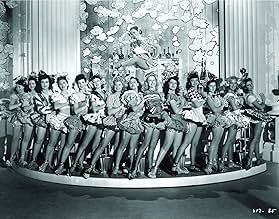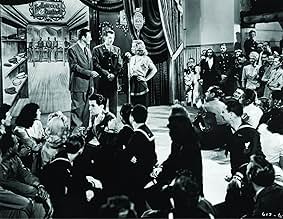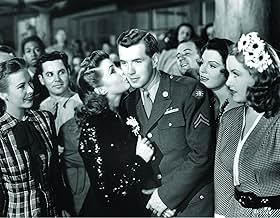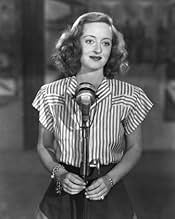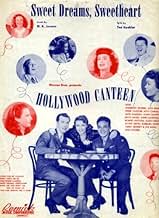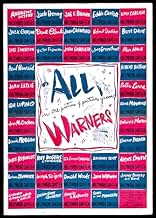Aggiungi una trama nella tua linguaTwo soldiers on leave spend three nights at a club offering free of charge food, dancing, and entertainment for servicemen on their way overseas. Club founders Bette Davis and John Garfield ... Leggi tuttoTwo soldiers on leave spend three nights at a club offering free of charge food, dancing, and entertainment for servicemen on their way overseas. Club founders Bette Davis and John Garfield give talks on the history of the place.Two soldiers on leave spend three nights at a club offering free of charge food, dancing, and entertainment for servicemen on their way overseas. Club founders Bette Davis and John Garfield give talks on the history of the place.
- Regia
- Sceneggiatura
- Star
- Candidato a 3 Oscar
- 3 vittorie e 3 candidature totali
- The Andrews Sisters
- (as Andrews Sisters)
Recensioni in evidenza
In 1942, actors John Garfield and Bette Davis, along with the former president of the Music Corporation of America, Dr. Jules Stein, opened up an exclusive club reserved only for servicemen called the Hollywood Canteen. There, men who were on leave from military service, whether local or from one of the allied countries, got to relax and enjoy food, drink, dancing, and entertainment from some of Hollywood's greatest performers until they were ordered to return to active duty. Many of the performers also served as waiters, dishwashers, and cooks, believe it or not. The canteen would stay open up until the end of the war in 1945. In 1944, however, the place was so popular amongst the public that Warner Brothers Pictures decided to make a musical motion picture based around the establishment.
This two-hour picture, filmed entirely in black-and-white, had one of the biggest star rosters in film history at the time, with most of the stars playing themselves, including founders Bette Davis and John Garfield, as well as Peter Lorre, Joan Crawford, Joe E. Brown, The Andrews Sisters, Jack Carson, Roy Rogers (along with Trigger, "the smartest horse in the movies"), among others. There is a story underlying this, though. It's about two Army soldiers who served in the South Pacific, with one of them, named Slim, falling in love with film actress Joan Leslie, who reminds him of his past fiancée. On the third night, Slim becomes the millionth customer, and wins a date with Joan. It then becomes a romantic drama between the two, as they both have feelings for one another. Thus, Joan makes it her goal to give Slim the best night he's ever had before he goes back to active duty.
Aside from the story, the film is mainly a variety show, featuring several musical numbers and skits performed by the stars. A musical, it may be, but it's not the kind of musical where a character sporadically breaks into song a la Rodgers & Hammerstein in order to move the plot along. Even though the underlying storyline is put aside throughout a good portion of the picture, the film does not stray from its main attraction: the canteen itself and what it accomplished for our troops. The film got mixed reception from critics upon release, but audiences were all over it, with 40% of the ticket sales going to the real canteen.
The film was enjoyable to watch, and serves as a time capsule of a bright moment in U.S. history during a dark time. Warner Bros. even made a parody/tribute of this film two years later via an animated Merrie Melodies short entitled "Hollywood Canine Canteen", which featured dogs that were reminiscent of Hollywood stars. This short can be seen as a bonus feature on the DVD. As for the film, an entertaining, yet informative watch for history and WWII buffs.
If you were at Warner Brothers in the '40s, you were in this movie, with very few exceptions. There was some wonderful musical performing as well, tops in my book being Carmen Cavallaro and Jack Benny's duet on the violin with Joseph Szigeti. You can also hear the Andrews Sisters, Roy Rogers and Trigger, Eddie Cantor, Benny Goodman and many others.
All of the women looked stunning, including Davis, Alexis Smith, Eleanor Parker, Jane Wyman, Joan Leslie, Barbara Stanwyck, Ida Lupino, Joan Crawford, and an unbelievably young and gorgeous Janis Paige. There were also appearances by Dennis Morgan, Jack Carson, Sidney Greenstreet, Helmet Dantine, Paul Henried, and Peter Lorre.
It was all very interesting but some of the numbers went on a bite long. However, if you're of that era, it will bring back some tremendous memories. Hutton (Barbara Hutton's cousin) was an interesting actor, likable and very reminiscent of Jimmy Stewart. He continued to work in Hollywood for another 30 years but never achieved stardom. Most fascinating to me was seeing and hearing Kitty Carlisle as she performed "Once to Every Heart," realizing that this film was made 62 years ago - and Kitty just performed her nightclub act, at 95, in New York City. God bless her.
By the way, female servicewomen were not allowed in the Hollywood Canteen. I can't remember who it was, but eventually someone started tea dances for the women soldiers to give them someplace to go on leave. For shame.
Robert Hutton plays Corporal Slim Green. A purple-heart winner on a one week leave in Hollywood, California. After catching the local sights, he goes to the Hollywoodcanteen for servicemen in the hopes of meeting his dream girl, Joan Leslie. The innocence of this romance is a real trip down memory lane; when a kiss, a gentle touch, and a starry-eyed stare meant everything.
Dane Clark as Hutton's sidekick from New York, Sgt. Nolan, steals the show. Clark is at his finest, as the wounded buddy trying his best to find a girl of his own. He finally does in the stunningly beautiful Janis Paige. As Angela, Paige is witty, sexy, and sets the screen ablaze.
The farewell ending at the train station (re-acted in the 1979 Richard Gere film, YANKS), is one of the most moving and romantic in screen history.
An enjoyable, upbeat, romantic, and entertaining movie.
*** (out of 4)
The Hollywood Canteen club was started by Bette Davis and John Garfield as a way for Hollywood to show support to U.S. Troops who were heading overseas. The club offered the service people a chance to meet, dance and be waited on by various celebrities from Hollywood. This movie here gathers up some of the biggest people in the business and we're given a side story of a soldier (Robert Hutton) getting a three day pass and spending it at the club where he meets and falls in love with Joan Leslie. If you're looking for a film with a story then you're not going to find it here. Many people have attacked this film for being stupid and I understand that but at the same time this thing offers up a chance to see the actual club and we also get some of the biggest stars every put together for a film. A lot of the cameos are rather silly and of course everyone is introduced by name but it's still quite fun seeing so many people in one film. Not only do we get Davis, Garfield and Leslie but there's dozens of other stars including the likes of Crawford, Stanwyck, Lorre, Greenstreet, Rogers (and Trigger), Benny, Parker, Alexis Smith, Ida Lupino, Henried, Brown and countless others. Seeing these stars in one picture is reason enough to check it out and there are also some musical numbers to keep you entertained. I think the film works best during the first hour when we're inside the club and the various stars are just making cameos. Once the love story kicks in things gets extremely silly and obviously staged but both Hutton and especially Leslie are charming enough to keep you slightly entertained. At 124-minutes the film does run out of gas before it's over with but film buffs should still enjoy it.
Lo sapevi?
- QuizOriginally conceived by Warner Bros. as a multi-studio (like the Hollywood Canteen) WWII effort with rival studios (Fox, Paramount, MGM, etc.) contributing cameo appearances by its stars. But when other studios balked at having performers appear (even though profits were reportedly earmarked for the war effort), Warner turned it into a single-studio affair.
- BlooperWhen "Slim" is sightseeing in Hollywood at the beginning of the film his infantry division patch (40th Div) is shown on his left shoulder. However, in one scene (right after the swimming pool), the patch is displayed on his right shoulder.
- Citazioni
Jack Carson: Don't get your hopes up, he's been Leslie-ized.
Jane Wyman: Oh will you stop, I've been Reagan-ized.
- Curiosità sui creditiOpening credits are displayed rising up over "Hollywood Canteen" sign.
- ConnessioniEdited into California at War (2007)
- Colonne sonoreDon't Fence Me In
(1934)
Music by Cole Porter
Lyrics by Cole Porter and Robert H. Fletcher (uncredited)
Performed by Roy Rogers (uncredited) and danced by Trigger (uncredited)
Also performed by The Andrews Sisters (uncredited)
Also played as dance music by Jimmy Dorsey and His Orchestra (uncredited)
I più visti
- How long is Hollywood Canteen?Powered by Alexa
Dettagli
- Data di uscita
- Paese di origine
- Lingua
- Celebre anche come
- Hollywood Canteen
- Luoghi delle riprese
- Brown Derby - 3377 Wilshire Boulevard, Los Angeles, California, Stati Uniti(in Hollywood montage)
- Azienda produttrice
- Vedi altri crediti dell’azienda su IMDbPro
- Tempo di esecuzione2 ore 4 minuti
- Colore
- Proporzioni
- 1.37 : 1
Contribuisci a questa pagina



